Ford ‘Escapes’ from mundane SUV compacts
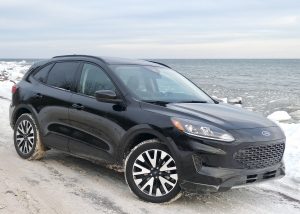
Snow, cold, and the climate of Lake Superior’s North Shore can make you want to escape, and the new Escape is the right vehicle.
By John Gilbert
Sly move, Ford. I capitulate in my questioning of the logic of Ford to not only quit building almost all of its sedans, but to announce it, alerting consumers that maybe they don’t want to risk buying a car that’s going out of existence.
The main reason for my yielding is the 2020 Ford Escape, which is the latest version of the compact SUV that helped trigger our country’s sweeping upsurge to the preference of trucks and SUVs over sedans. While granting that most buyers of SUVs and compact SUVs will stress that they want to be seated a little higher to aid in traffic visibility — and clucking at the certainty that the sightline advantage is pretty well eliminated when you stop at a crowded intersection and notice that 29 out of 30 cars in your field of vision are also SUVs — the new Escape comes very close to merging the best assets of a car and SUV.
We’re all pretty accustomed to the slightly boxy Escape during its formative years and later development, but the new model is much sleeker, much more stylish, and nobody can utter the criticism of it being boxy. There is a definite movement toward sportier and more stylish compact SUVs, with Mercedes, Infiniti, Lexus, and BMW leading the way with lofty standards of styling and technology. The two standards of the segment are the Honda CR-V and the Toyota RAV4, and even they have grown more rounded and stylish, although nowhere near the new Escape’s bold venture.
Ford also has taken an adventurous step in powertrains, leaving its U.S. competitors behind by being first to downsize its engines for fuel economy, and turbocharging them under the heading “EcoBoost” to jack up their power and performance. Others are following now, but Ford put the standard out there and keeps adding refinement.
The test vehicle was the Escape SE Sport AWD Hybrid, which encompasses a lot of technology under those rakish lines. The base Escape now is available with a 1.5-liter 3-cylinder turbo, an engine that is surprisingly capable with its 181 horsepower and 190 foot-pounds of torque, especially in the front-wheel-drive model. Next up, there is a 2.0-liter turbo that has 250 horsepower and 280 foot-pounds of torque that powers the Titanium all-wheel drive model from 0-60 in less than 7 seconds — nearly two seconds quicker than the others.
The test car came with Ford’s 2.5-liter dual-overhead camshaft 4, with Atkinson cycle control of its valve train, electronically linked up with a continuously variable transmission, all of it collaborating to develop 198 horsepower, distributed to all four wheels, and further adjustable with selectable drive modes from a console switch. The gas engine is augmented by electric motors, helping boost the economy-minded 2.5 for prompt delivery of those 198 horses.
Once you start it up, you rotate a knob on the console to get into drive, and you’re off. That round knob replaces a large and clunky shift lever that takes up a lot of room that could be devoted to other switchgear, or to those helpful little cubbies for charging cell phones or stashing sunglasses.
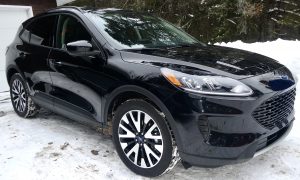
Looking rich in black, with black accented alloy wheels, the Escape as an AWD Hybrid is also luxurious.
Black-accented 19-inch alloy wheels replace the standard 17s as part of the SE Sport Premium package, which also adds a power lift gate, panoramic sunroof, remote start and adaptive cruise control, added to the extensive equipment with 12.3-inch digital instrument cluster, the SYNC 3 connectivity with 8-inch touchscreen and Apple CarPlay or Android Auto, plus Ford’s Co-Pilot360 Technology. That adds blind spot information, cross-traffic alert, pre-collision assist with automatic emergency braking, pedestrian detection, forward collision warning and dynamic brake support.
The FordPass Connect has 4G WiFi hotspot connections for 10 mobile devices. Heated seats include front 10-way power driver’s seat and a handy sliding second row with a rear-air duct for Great White North winters. The seats are made of something called ActivX, which is some magical fabric that is pleasing enough that nobody will pine for real leather.
Remote start remains one of the most appreciated items when it’s below-zero out, and the adaptive stop and go helps reduce fuel usage in traffic and can help you get up and over 30 miles per gallon.
The bottom line becomes the bottom line for the Escape, because it starts in SE Sport form with AWD at $29,755, and loading it up with all the optional equipment boosts the sticker to $34,245, including destination and delivery, which I always thought was about the same thing.
One word of caution is when you go to a Ford dealer to check out the Escape,
look carefully, because Ford has filled their showrooms with assorted SUVs, almost all of which seem to have undergone recent renovation, such as the Explorer. But keep looking, because the Escape may be that sleek little thing off to one side, and you could overlook it if you’re not thorough. Once you find it, you’ll know why you were looking for it.


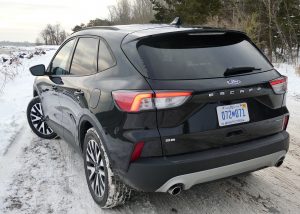
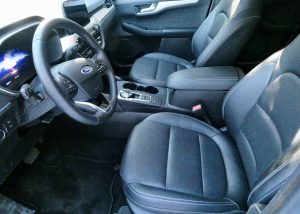
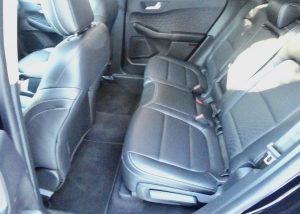
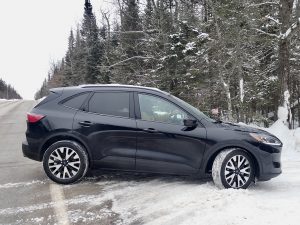
 John Gilbert is a lifetime Minnesotan and career journalist, specializing in cars and sports during and since spending 30 years at the Minneapolis Tribune, now the Star Tribune. More recently, he has continued translating the high-tech world of autos and sharing his passionate insights as a freelance writer/photographer/broadcaster. A member of the prestigious North American Car and Truck of the Year jury since 1993. John can be heard Monday-Friday from 9-11am on 610 KDAL(www.kdal610.com) on the "John Gilbert Show," and writes a column in the Duluth Reader.
John Gilbert is a lifetime Minnesotan and career journalist, specializing in cars and sports during and since spending 30 years at the Minneapolis Tribune, now the Star Tribune. More recently, he has continued translating the high-tech world of autos and sharing his passionate insights as a freelance writer/photographer/broadcaster. A member of the prestigious North American Car and Truck of the Year jury since 1993. John can be heard Monday-Friday from 9-11am on 610 KDAL(www.kdal610.com) on the "John Gilbert Show," and writes a column in the Duluth Reader.